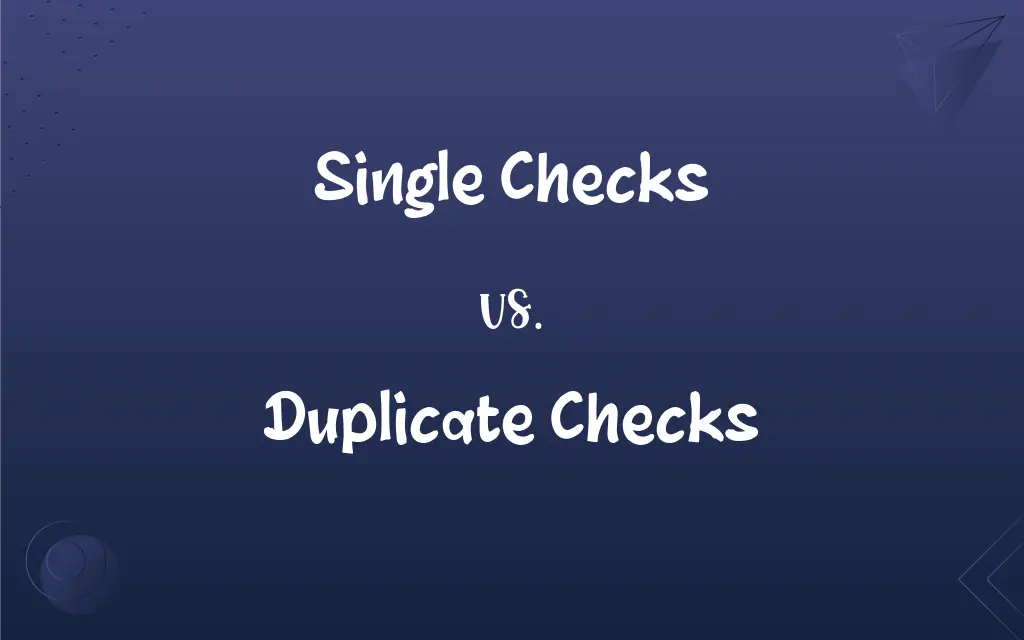Single Checks vs. Duplicate Checks: What's the Difference?
Edited by Aimie Carlson || By Harlon Moss || Updated on June 9, 2024
Single Checks are individual check pages, while Duplicate Checks provide an automatic carbon copy for record-keeping.

Key Differences
Single Checks refer to standard checks that are utilized for payment or other financial transactions. Once written, they provide no automatic backup for the user. These are simple, straightforward, and offer no immediate record other than the check itself. On the other hand, Duplicate Checks are designed with an added layer: a carbonless copy beneath the primary check. This feature allows the user to retain an instant copy for their records, ensuring an easy reference without the need to make manual duplicates.
Single Checks are often preferred for their simplicity and might be chosen by those who maintain digital records or manually record each transaction. Duplicate Checks, on the other hand, offer an immediate paper trail. Every time a check is written, the duplicate provides an instant copy, which can be helpful for both businesses and individuals who want a hassle-free method to track their payments.
In the realm of personal finance and business accounting, the choice between Single Checks and Duplicate Checks often comes down to preference and record-keeping habits. For those who trust their manual recording system or utilize digital tracking, Single Checks may suffice. However, for those who appreciate the convenience of immediate paper backup, Duplicate Checks are the go-to choice.
Cost can also be a consideration. Typically, Single Checks might be less expensive due to the lack of a carbon copy feature. Duplicate Checks, given their additional utility and material, usually come at a slightly higher price. Regardless of the choice, both Single Checks and Duplicate Checks serve the primary function of facilitating payments, with the difference lying in their record-keeping features.
Comparison Chart
Functionality
Facilitates payments without automatic backup
Facilitates payments with an automatic carbon copy
ADVERTISEMENT
Record-keeping
Manual recording needed for backup
Immediate paper backup provided
Cost
Typically less expensive
Might be slightly more expensive due to carbon copy
Usage Preference
Preferred by those with digital/manual tracking
Preferred by those wanting immediate paper backup
Material
Standard check material
Check material plus carbonless copy layer
Single Checks and Duplicate Checks Definitions
Single Checks
Checks without any automatic backup mechanism.
I prefer Single Checks since I keep a digital record of all transactions.
ADVERTISEMENT
Duplicate Checks
Checks with an automatic carbonless copy.
I love using Duplicate Checks because they offer instant backup.
Single Checks
Standard financial instruments used for payments.
My Single Checks booklet is almost finished; I need to order more.
Duplicate Checks
Provide immediate paper records of transactions.
Every time I write a check, Duplicate Checks give me a copy for my files.
Single Checks
Checks that require manual recording for backup.
Using Single Checks means I have to jot down each payment in my register.
Duplicate Checks
Often preferred by businesses for easy record-keeping.
Our company always orders Duplicate Checks for better financial tracking.
Single Checks
Simpler and often cheaper than their duplicate counterparts.
I opted for Single Checks to save some money on my order.
Duplicate Checks
Financial tools that ensure easy tracking of payments.
With Duplicate Checks, I don’t worry about forgetting any payment details.
Single Checks
Individual check pages used for transactions.
I ordered a booklet of Single Checks from my bank.
Duplicate Checks
More expensive than single checks due to the carbon copy feature.
Though Duplicate Checks cost more, the convenience they offer is unmatched.
FAQs
How do Duplicate Checks differ from Single Checks?
Duplicate Checks offer an automatic carbonless copy for each transaction, unlike Single Checks.
Why might someone prefer Single Checks?
They might prefer the simplicity, have a digital recording system, or want to save on costs.
Are there digital versions of Duplicate Checks?
While there are digital check services, the concept of a "duplicate" is inherently tied to physical checks.
Can I choose designs for both Single Checks and Duplicate Checks?
Yes, many providers offer a range of designs for both types.
Which is more popular: Single Checks or Duplicate Checks?
It depends on individual and business preferences; both have their unique advantages.
Do banks offer both Single Checks and Duplicate Checks?
Most banks offer both options, but it's always good to inquire directly.
What are Single Checks?
Single Checks are standard checks used for payments without an automatic backup.
Do I need to manually record transactions with Single Checks?
Yes, Single Checks require manual recording for backup since they don't provide an automatic copy.
Are there any other differences besides record-keeping?
Cost can be a difference, with Single Checks often being less expensive.
Is it easier to forge Duplicate Checks than Single Checks?
The ease of forging isn't necessarily tied to the type of check but more to security features in place.
Can I switch from Single Checks to Duplicate Checks with my current checkbook?
No, you'd need to order a new set of Duplicate Checks from your bank or supplier.
Do I need a special pen to write on Duplicate Checks?
No, a regular pen works, but applying consistent pressure ensures a clear duplicate.
How long should I keep the duplicates from my Duplicate Checks?
It's advisable to retain them for at least a year for personal reference and longer for business or tax purposes.
Are Duplicate Checks more expensive than Single Checks?
Typically, yes. Duplicate Checks might cost more due to the additional carbon copy feature.
Can I get Single Checks with added security features?
Yes, many providers offer enhanced security features for both Single and Duplicate Checks.
Who might benefit most from Duplicate Checks?
Those wanting immediate paper backup and businesses that require easy record-keeping.
Is the carbon copy in Duplicate Checks always clear?
Generally, yes, but the clarity might depend on the quality of checks and the pressure applied while writing.
Are Duplicate Checks environmentally friendly?
It depends on the provider, but some might offer eco-friendly options.
Are Duplicate Checks bulkier than Single Checks?
Yes, because of the added carbonless copy layer, they might be slightly thicker.
Do both Single Checks and Duplicate Checks serve the same primary function?
Yes, both facilitate payments; the difference is in their record-keeping features.
About Author
Written by
Harlon MossHarlon is a seasoned quality moderator and accomplished content writer for Difference Wiki. An alumnus of the prestigious University of California, he earned his degree in Computer Science. Leveraging his academic background, Harlon brings a meticulous and informed perspective to his work, ensuring content accuracy and excellence.
Edited by
Aimie CarlsonAimie Carlson, holding a master's degree in English literature, is a fervent English language enthusiast. She lends her writing talents to Difference Wiki, a prominent website that specializes in comparisons, offering readers insightful analyses that both captivate and inform.































































